Slow cooking releases more flavor from herbs through a gradual breakdown of their cellular structure. When you cook herbs slowly, heat gently breaks down their cell walls, allowing essential oils and compounds like alkaloids and polyphenols to seep into your dish. Hard herbs like rosemary and thyme particularly benefit from this process, as their thick, lignin-rich stems need time to release their complex flavors. The low, steady temperature (around 180-280°F) in your slow cooker also creates a continuous steam cycle that helps extract water-soluble compounds. Understanding these mechanisms will help you maximize the flavors in your next slow-cooked meal.
Chemical Structure of Herbs

When examining herbs at their molecular level, you'll discover a complex array of chemical compounds that give them their distinctive flavors, aromas, and therapeutic properties.
You'll find alkaloids, which are nitrogen-containing compounds synthesized from amino acids, and polyphenols with their multiple aromatic rings that provide antioxidant benefits.
Terpenoids and volatile oils make up another important group in herbs' chemical makeup. You'll notice these oils are released when you break the plant's cell walls during cooking.
The herbs also contain glycosides and saponins, which are often bound to sugar molecules. These compounds evolved over 3 billion years as plants adapted to various environmental challenges. Specific compounds like alkylamides give certain herbs, such as Echinacea, their characteristic tingling sensation, while coumarins, derived from phenylalanine, contribute to both flavor and biological activities.
Heat and Essential Oil Release
Although essential oils give herbs their distinctive aromas and flavors, heat plays a delicate role in their release and preservation. You'll need to strike a careful balance when using heat to extract herbal properties. While temperatures between 100-120°F help break down plant material and enhance extraction, exceeding these limits can damage the oils.
When you're slow-cooking herbs, use indirect heat methods like a crockpot or double boiler to maintain controlled temperatures. You'll want to stir regularly and monitor the heat closely, as essential oils can be particularly sensitive. A 1:5 herb-to-oil ratio ensures optimal extraction of therapeutic compounds from the plant material.
Citrus oils start breaking down above 100°F, while delicate absolutes like jasmine can degrade at just 90°F. For the best results, keep checking the temperature throughout the 2-4 hour infusion process to preserve the therapeutic qualities of both essential and carrier oils.
Time-Temperature Relationship in Cooking
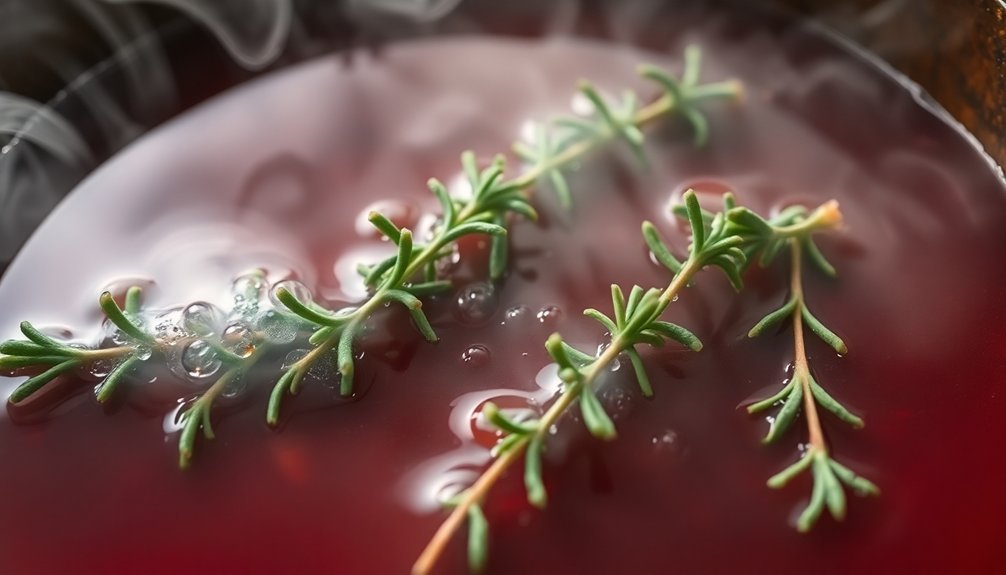
The strategic balance between cooking time and temperature directly shapes how herbs release their flavors into your dishes. When you're slow-cooking with herbs, you'll need to take into account their structure and flavor compounds. Woody herbs like rosemary and thyme can withstand long cooking times at low temperatures, while delicate herbs like basil and parsley should be added near the end. Understanding optimal temperature ranges for different herbs helps determine their best cooking applications, as herbs like basil thrive at higher temperatures than mint or cilantro. You'll get the best results by matching your herbs to appropriate cooking times and temperatures, allowing their essential oils to release gradually without degrading their unique flavors.
| Time | Temperature | Herb Type |
|---|---|---|
| 2-3 hours | Low (200-250°F) | Woody herbs |
| 1-2 hours | Medium (300-350°F) | Sturdy herbs |
| 30-45 min | Medium-high (350-400°F) | Dried herbs |
| 10-15 min | High (400-450°F) | Leafy herbs |
| 1-5 min | Finishing (below 200°F) | Delicate herbs |
Cellular Breakdown During Cooking
Understanding cellular breakdown in herbs reveals the science behind their flavor release during cooking. When you chop or grind herbs, you're breaking down their cell walls, which releases essential oils and enhances their fragrance.
During slow cooking, heat gradually breaks down these cellular structures further, allowing more compounds to emerge. You'll notice that different herbs react uniquely to heat. Robust herbs like rosemary and thyme can withstand longer cooking times, while delicate ones like parsley lose their potency quickly.
The breakdown process also releases beneficial compounds – phytochemicals like rosmarinic acid and allicin provide health benefits. When you're slow cooking, you'll get the most flavor by using an herb sachet or bouquet garni, which allows for controlled release while keeping herbs contained.
This method guarantees you'll capture both subtle background notes and distinctive flavors.
Liquid Extraction Methods
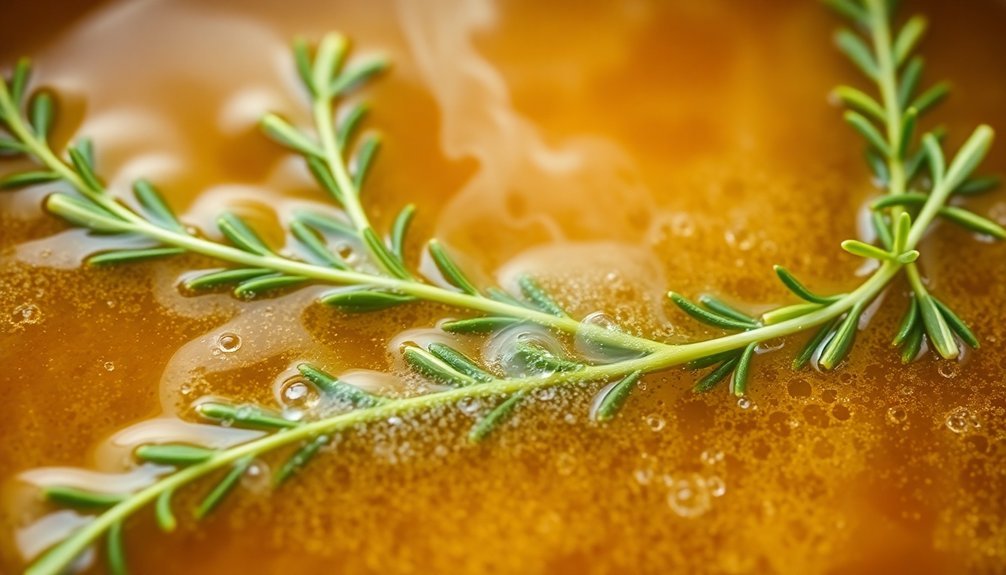
While herbs release flavors through cellular breakdown, liquid extraction methods offer precise control over their aromatic compounds.
You'll find that steam distillation is particularly effective for preserving delicate flavors, as steam gently carries volatile compounds without direct heat exposure. This method works especially well with cloves and cinnamon.
If you're looking for different flavor profiles, simple distillation with water or ethanol can create unique tastes through controlled chemical reactions.
For more concentrated results, you might opt for solvent extraction using alcohol or hexane, which is particularly effective with seeds and nuts.
Don't overlook the traditional infusion method – it's perfect for making broths and sauces, where herbs slowly release their flavors into the cooking liquid.
Remember that heartier herbs can withstand longer infusion times, while delicate ones need gentler treatment.
Hard Vs Soft Herb Properties
Looking at herb cell structure, you'll notice hard herbs have thick, woody stems and tough leaves that protect their essential oils during extended cooking periods, while soft herbs feature delicate cell walls that quickly break down under heat.
When slow-cooking, hard herbs gradually release their essential oils into your dish as their fibrous tissues soften, creating deep, complex flavors that intensify over time.
In contrast, soft herbs' fragile cell structures rupture rapidly when exposed to heat, causing their essential oils to dissipate quickly and their textures to deteriorate, which is why they're best added at the end of cooking or used raw.
Essential Oil Release Patterns
Distinct patterns emerge when comparing how hard and soft herbs release their essential oils during cooking.
You'll find that hard herbs like rosemary and thyme need heat to fully release their potent flavors, while soft herbs such as basil and cilantro release their oils quickly without heat.
When you're slow-cooking with hard herbs, they'll gradually rehydrate and infuse your dish with their essential oils, creating deep, complex flavors.
The heat activates compounds like camphor and 1,8-cineole, which are responsible for their distinctive tastes.
In contrast, soft herbs contain delicate compounds that break down quickly under heat.
That's why you'll want to add them at the end of cooking or use them raw.
Their fresh, lighter flavors come from compounds like linalool and eugenol, which don't require heat activation.
Texture Breakdown Over Time
The breakdown of herbs during slow cooking reveals stark differences between hard and soft varieties.
You'll notice that hard herbs like rosemary, thyme, and sage maintain their structure and continue releasing flavor throughout long cooking periods. These sturdy herbs work perfectly in slow-cooked dishes like casseroles and roasts.
In contrast, soft herbs such as parsley, mint, and cilantro quickly deteriorate when exposed to prolonged heat. They'll lose both their texture and aromatic compounds, becoming lifeless and bland. That's why you'll want to add soft herbs near the end of cooking or just before serving.
While oregano is technically a soft herb, it behaves more like a hard herb, making it suitable for extended cooking times.
To preserve texture, you'll get better results storing dried herbs in airtight containers away from light and heat.
Herb Cell Structure Analysis
When examining herbs at a cellular level, stark differences emerge between hard and soft varieties due to their unique cell wall compositions. You'll find that hard herbs like rosemary and thyme have rigid, lignin-rich cell walls that can withstand extended cooking times, while soft herbs like basil and parsley contain delicate cell structures that break down quickly.
| Feature | Hard Herbs | Soft Herbs |
|---|---|---|
| Cell Wall | Rigid, woody | Delicate, flexible |
| Stem Type | Woody, tough | Tender, juicy |
| Heat Response | Slow flavor release | Quick breakdown |
| Cooking Time | Long-lasting | Short duration |
| Best Uses | Slow cooking, braising | Fresh garnish, quick sauté |
The cell wall composition affects how flavors are released during cooking. Heat gradually breaks down hard herbs' sturdy walls, allowing flavors to infuse slowly, while soft herbs release their compounds rapidly due to their fragile structure.
Slow Cooking Temperature Control

Mastering temperature control in slow cooking guarantees ideal herb flavor extraction and development.
You'll find that slow cookers operate primarily on two settings: low (180°F) and high (280°F). While the low setting takes about 8 hours, the high setting cuts cooking time to 4 hours while maintaining flavor integrity.
Your slow cooker's sealed environment guarantees even heat distribution, preventing herb flavors from burning or developing unevenly.
This consistency is particularly important when you're working with tougher herbs like rosemary and thyme. The prolonged, steady heat helps rehydrate dried herbs and gradually releases their essential oils.
You'll want to monitor your dish periodically and adjust herb quantities as needed.
Consider using an herb sachet to control flavor intensity, and remember that longer cooking times allow for fuller flavor extraction.
Moisture Retention in Herbs
When you're slow cooking with herbs, you'll notice that water-soluble flavor compounds gradually release into your dish as moisture circulates through the cooking environment.
The steam that builds up in your slow cooker creates a continuous cycle of moisture that helps extract and distribute herbal flavors throughout the meal.
This constant circulation of herbal-infused steam guarantees that both dried and fresh herbs release their full potential of aromatics and flavors during the extended cooking process.
Water-Soluble Flavor Compounds
Understanding moisture retention in herbs is essential for preserving their water-soluble flavor compounds. When you're working with herbs, their high water content plays a vital role in how their flavors are released during cooking.
Dried herbs need time to rehydrate and release their concentrated flavors into your dishes, especially in slow-cooked meals.
To get the most from your herbs' water-soluble compounds:
- Add dried herbs early in the cooking process to allow proper rehydration
- Use slow-cooking methods (45+ minutes) for ideal flavor infusion
- Store dried herbs in airtight containers to prevent moisture absorption
- Label and date your containers to track freshness
The key is maintaining the right balance between moisture and heat. While high water content can lead to molding in fresh herbs, proper drying and storage help preserve their essential flavor compounds for up to a year.
Herbal Steam Circulation
The circulation of herbal steam plays an essential role in preserving moisture content and aromatic properties during preparation. When you add herbs to hot water, their volatile oils combine with steam to create a potent aromatic mixture. This process helps the herbs retain their moisture while distributing their beneficial compounds throughout the cooking vessel.
You'll find that steam's gentle penetrating action helps extract and preserve delicate flavors from both fresh and dried herbs. Whether you're using rosemary, thyme, or sage, the steam carries their aromatic constituents and helps them infuse evenly into your dish.
The continuous circulation of steam also prevents the herbs from drying out too quickly, allowing their flavors to develop fully over time. This natural diffusion process works better than aggressive cooking methods that might damage the herbs' delicate compounds.
Flavor Compounds and Heat

Heat's transformative power dramatically affects how flavor compounds interact with food, creating complex chemical reactions that can either enhance or diminish taste.
When you're slow-cooking with herbs, heat accelerates these interactions between flavor components and other ingredients like proteins and starches.
Here's what happens when heat meets herbs and other ingredients:
- The Maillard reaction occurs between reducing sugars and proteins, creating new flavors and appealing brown colors.
- Dried herbs release concentrated essential oils as they rehydrate in your dish.
- Different heating methods affect texture and mouthfeel, which influences how you perceive flavors.
- Heat can cause proteins to denature and interact with other chemicals, forming new flavor compounds.
Understanding these reactions helps you make better decisions about when to add herbs and how long to cook them.
Solar Energy Impact
Modern solar drying technologies have revolutionized herb preservation by maximizing flavor retention while minimizing energy costs. You'll find that these systems protect your herbs from direct sunlight while maintaining ideal drying conditions through light-protected chambers and consistent temperatures.
| Feature | Benefit | Impact |
|---|---|---|
| Protected Chambers | Preserves essential oils | Enhanced flavor |
| Filtered Air | Prevents contamination | Better quality |
| Even Distribution | Uniform drying | Consistent results |
| Solar Power | Zero carbon footprint | Eco-friendly |
| Adjustable Trays | Multiple herb types | Versatile use |
The technology's horizontal airstreams guarantee your herbs dry evenly, while integrated filters keep the process hygienic. You won't need electricity or additives, making it a cost-effective solution for preserving your harvest. The portable design lets you maximize sun exposure while maintaining professional-grade results.
Herb Preparation Techniques
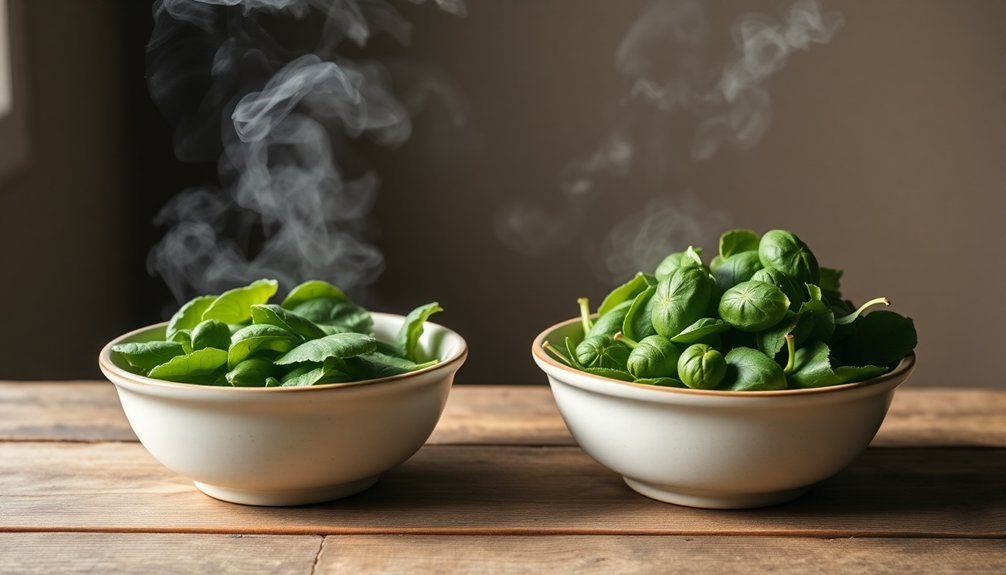
Mastering three essential herb preparation techniques will transform your cooking results. When you chop herbs finely, you'll break down cell walls to release more intense flavors and aromas.
For whole herbs, wrap them in cheesecloth before adding to long-cooking dishes, making removal easier when serving.
To maximize flavor release in your slow-cooked dishes:
- Use a rocking motion with your knife when chopping herbs and garlic together to enhance flavor profiles.
- Add hardy herbs like rosemary and thyme at the beginning of cooking for slow flavor release.
- Store fresh herbs properly by placing stems in water and covering loosely with plastic.
- Crush dried herbs between your fingers before adding them to release more intense flavors.
Remember that whole herbs need longer cooking times to draw out their full potential, while chopped herbs release flavors more quickly.
Optimal Cooking Duration Points
When slow-cooking with herbs, you'll find that time and temperature play vital roles in flavor development, as heartier herbs like rosemary and thyme need at least 20 minutes to release their full potential.
You can control the intensity of herb flavors by adding them at specific points during cooking: long-simmering dishes benefit from early addition of robust herbs, while delicate herbs work best in the final minutes.
For best results, you'll want to monitor the temperature carefully, as excessive heat can diminish the herbs' essential oils and compromise their flavor contribution.
Time-Based Flavor Release
Understanding how herbs release their flavors at different cooking durations is essential for achieving the perfect taste in your dishes.
You'll find that dried herbs excel in slow cooking because they need time to rehydrate and gradually infuse their concentrated flavors throughout the meal.
- Add dried herbs like rosemary, oregano, and thyme at the beginning of slow cooking to guarantee complete flavor release.
- Save delicate fresh herbs such as basil, cilantro, and parsley for the final 1-2 minutes of cooking.
- Use hardier fresh herbs like rosemary and thyme in the last 20 minutes of cooking.
- Plan to add fresh herbs to uncooked dishes several hours before serving to allow flavors to blend properly.
Temperature Controlled Infusion
The precise control of temperature during herb infusion builds upon the timing principles of slow cooking to maximize flavor extraction.
You'll achieve the best results by maintaining temperatures around 100°F (38°C), as this allows herbs to release their flavors without degrading their essential properties.
Your choice of heat source matters greatly. While you can use a stovetop for reliable control, alternatives like sous-vide machines offer precise temperature regulation.
For delicate herbs, you'll want to stick to lower temperatures, while tougher ingredients like bark and roots benefit from slightly higher heat.
Don't let your infusion exceed 140°F, as this can damage both the oil and herb flavors.
Remember to store your finished infusions in dark bottles and refrigerate them promptly.
For safety, you'll need to use refrigerated infusions within 2-3 days.
Frequently Asked Questions
Can Slow-Cooked Herbs Become Toxic if Left Cooking Too Long?
You don't need to worry about herbs becoming toxic from extended cooking. While they might lose flavor or become bitter, they won't become dangerous. Just follow proper food safety guidelines for overall meal preparation.
Do Different Cooking Vessels Affect How Herbs Release Their Flavors?
Yes, your cooking vessel matters. Slow cookers trap more steam than casserole dishes, affecting herb flavor concentration. However, it's the cooking method, not the vessel material, that'll make the biggest difference in flavor release.
Should Herbs Be Bundled or Scattered When Slow Cooking?
You'll get better results by bundling hardy herbs like rosemary and thyme in a sachet for easy removal, while scattering dried herbs throughout your dish guarantees even flavor distribution in slow cooking.
How Does Altitude Affect Herb Flavor Release in Slow Cooking?
At higher altitudes, you'll need to cook longer since water boils at lower temperatures. You should add more liquid and cover your dishes to prevent herb flavors from evaporating too quickly during cooking.
Can Overused Slow Cooker Herbs Taint Future Dishes With Lingering Flavors?
Yes, your slow cooker can retain lingering herb flavors if not cleaned properly. You'll notice this especially with strong herbs like rosemary and thyme. Clean thoroughly between uses to prevent unwanted flavor transfer.
In Summary
You'll find that slow-cooked herbs release more flavor because heat gradually breaks down their cellular walls, allowing essential oils and flavor compounds to seep into your dish. The extended cooking time lets these compounds fully dissolve and blend with fats and liquids, creating deeper, more complex flavors. It's also why you'll notice more intense aromas when herbs simmer slowly rather than cook quickly.


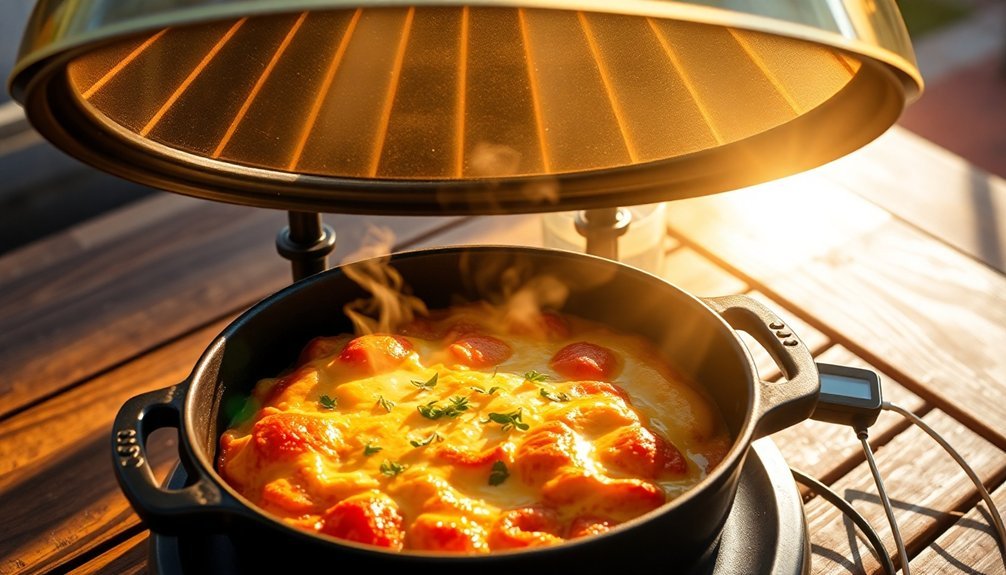

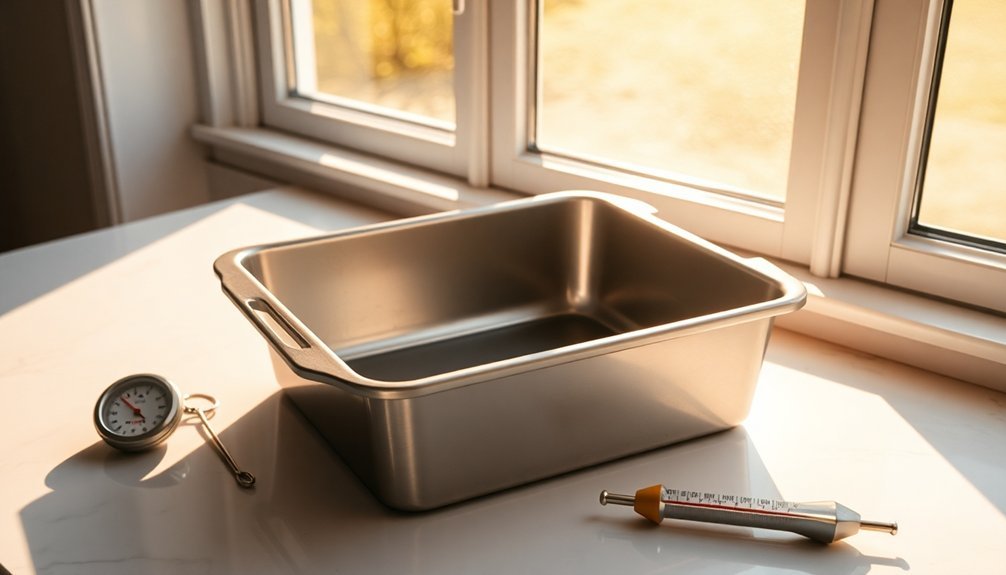
Leave a Reply